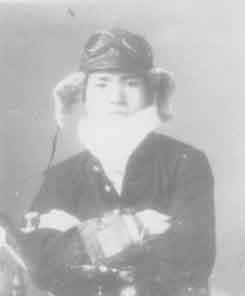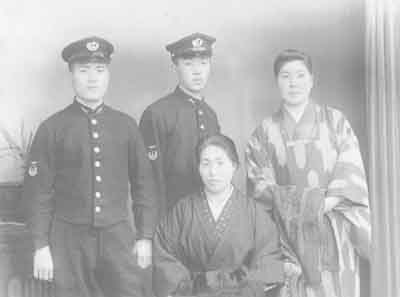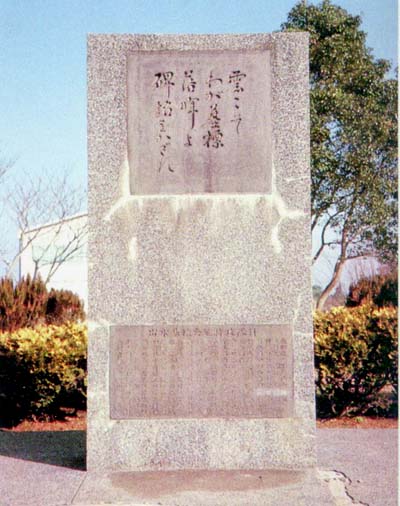As December comes again this year, the season when the first snow is likely to fall has begun. I sincerely apologize for not writing for such a long time. I trust that everyone in your family is in good health. Thank you very much for your previous letter about publishing records of those who died in the war. In regards to your inquiry as to whether any mementos or letters remain, it appears nothing remains in our home. In June 1953, the rice paddies, fields, and houses here suffered serious damage when the Chikugo River flooded, so probably nothing survived. It seems no last letters were sent. There were only two photographs, so I am sending them to you. On December 1, 1944, my mother and I left home early in the morning to see Kensuke, who was training with the flight corps at Usa Air Base. It was very cold, and every morning there was frost. A light snow was gently falling. My mother and I brought a meal and chimaki (rice cakes wrapped in bamboo leaves) as a gift. We walked to Yoshii Station on the Kyudai Line and rode the train from there. It was already near evening when we arrived at Yanagigaura Station. Our destination was the second floor of a large farmhouse like our former one. The road there seemed to have suffered flood damage, and the rice paddies and fields were also washed away. I remember walking through such a place. Previously my mother had visited once with my father, so we arrived without a problem to the dim second-floor room. Since we came well prepared with charcoal, we made a fire to warm ourselves and waited for Kensuke to come. After a while he came and said, "Let's go together tomorrow to visit Usa Shrine. I'll come in the morning to pick you up." He soon returned. The next day on December 2 he and a friend came to get us, and we four walked slowly along the shrine path while talking together. Our smiling mother seemed very happy. We visited the main shrine, and I remember that he prayed sincerely for his fortune in battle. Below are photos taken at a nearby photography studio after our visit to the shrine. |
|||||||
|
|||||||
|
Then we said good-bye to Kensuke and his friend at Yanagigaura Station as they returned to base. That was our final good-bye. The photos were the last ones. At the beginning of 1945 he was transferred to the Izumi Flight Corps in Kagoshima Prefecture. There was a letter from him asking whether we could come to Izumi, but even my mother did not go to see him because of the intense air raids and the difficulty in getting a train ticket. Afterward on about April 20, a letter arrived from Mrs. Fumie Harada of Saga Prefecture. The letter said that the bomber that Kensuke boarded on April 16 to sortie to the sea around Okinawa did not return the next day. Mrs. Harada went to meet one of Kensuke's younger brothers, and he heard the story then. I still do not forget this sad news from 52 years ago. My mother after that at night when it became quiet used to sing "A Young Eagle's Song" over and over in a lonely voice before the Buddhist family altar in our home. We comforted each other while I also recited Buddhist scriptures each night. Mother little by little finally settled down in June as the busy farming season started and we worked to increase food production. "A Young Eagle's Song" was a big hit and sold 230 thousand copies from 1944 until the end of the war in 1945. My father passed away in 1949, and my mother in 1975. My husband is disabled on the right side of his body. He is now 80 years old, and he receives home medical care through our town's welfare department. I am healthy and try to do my best, and we two somehow manage together. My husband joined the Sasebo Naval Corps when he was young and also took part in the war. When the war ended, he was working in the northern seas on the coastal defense ship named the Etorofu. His parents cried for joy when he returned safely. My deceased mother brought up four boys. Three were killed in the war (two in battle, one by disease contracted at the battlefront). I think it was very painful for her deep inside her heart. She participated with her husband in the unveiling ceremony of the Special Attack Forces Monument at Izumi Air Base, and she visited there several times after that. |
|||||||
|
|||||||
I receive an invitation each year to the April 16 memorial service sponsored by the Special Attack Forces Honor Society and held in front of the monument. I remember the war from long ago as I stand in front of this monument in Peace Park. I pray deeply for the continued development of Izumi City and for the health of all its citizens. I wish to deeply thank everyone in the12th Ko Flight Training Program. I hope you live long and continue healthy. Misue Eto |
|||||||


